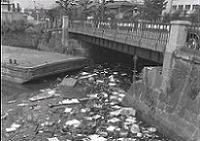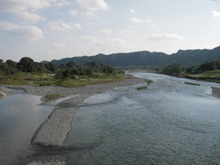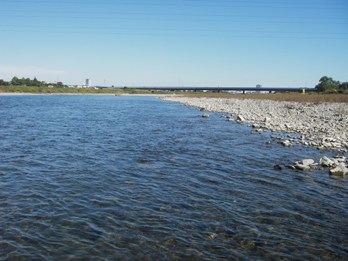
< World's WATERFRONT:JAPAN Category: Nature oriented restoration >
Before(1970s)
(source: Tokyo Metropolitan Gov.)
|
|
After
(source: Keihin Office of River)
|
Tama River, with Ogouchi Dam (called Okutama Lake), completed in 1957, and with tourist facilities, has been a relaxation and recreation area for Tokyoites. But its midstream and downstream in Tokyo and Kanagawa have been urbanized as residential and industrial areas. During the high-growth period in 1965-75, its water quality was deteriorated and the variety of the water usage increased. Residents gradually needed more orderly space usage.
Recently natural life has returned to the area as the sewage system penetrated and the water quality improved.
>>More details (PDF 109KB)
By JRRN-secre | Category: Nature oriented restoration,Kanto | Comment(0) | Trackback(0) |
Date: 2012.01.05 16:13
In the "Azami-no-se" area of Matsuura River running through Matsuura County of Saga Prefecture, people have long suffered from flood damage. Therefore the retarding method has been adopted as the flood countermeasure instead of building embankments in this region and resident-participation projects to recover organisms in the valuable river environment and regenerate the contact between people and organisms are being promoted. As a result, a traditional fishing method has been revived and children have begun to play by the riverside again. In this way, the connection between people and nature has been regenerated.
By JRRN-secre | Category: Nature oriented restoration,Community and urban river restoration,Kyushu | Comment(0) | Trackback(0) |
Date: 2011.09.10 18:12
In Yodo River running through Osaka, earth and sand are deposited around the spur dike, which was built to maintain the course for cargo ships, and many pools and valuable habitats for organisms have been created. However, because the water level fluctuation has decreased as a result of the construction of Yodo River Great Weir downstream, its environmental impact on Johoku pools is a concern.
For this reason, an experiment toward the recovery of the pool environment is being conducted by improving the operation of the weir to increase the water level fluctuation and improve the in-pool water quality.
By JRRN-secre | Category: Nature oriented restoration,Navigation restoration,Kinki | Comment(0) | Trackback(0) |
Date: 2011.09.10 18:09
At the mouth of Shonai River and Shin River, Fujimae mud flats spread, which is well known for visiting natatorial birds. Downstream of Shonai River, sand deposition is accelerated on the riverside, causing a floristic variation from reeds to miscanthus sacchariflorus and willow tree communities in the riverbed. At the same time, poor waterfront vegetation caused by decreasing flood frequency has become a problem in the areas used for agriculture and as a playground.
Under the circumstances, a project is being conducted to regenerate the waterfront vegetation such as the reed beds by excavating the riverbed to reduce the waterfront gradient and recover the frequency of floods in the riverbed following the heavy rain in Tokai in 2000.
By JRRN-secre | Category: Nature oriented restoration,Chubu | Comment(0) | Trackback(0) |
Date: 2011.09.10 18:07
In midstream Chikuma River in Nagano Prefecture, most of the banks and side bars were pebble riverbeds until the Meiji Period. These days, however, the vegetation grows thickly in many places while waterfront plants such as reeds and cattails are disappearing rapidly. This is because the channel has become static as the riverbed has lowered and the frequency of flooding reduced.
For this reason, a natural regeneration project research was started in 2002 to regenerate the diversified functions of the river. In Awasa district of Chikuma City, a trial excavation experiment is being conducted to study the shape of the channel to be excavated as well as the excavation method so that a river environment unique to Chikuma River may be regenerated.
By JRRN-secre | Category: Nature oriented restoration,Chubu | Comment(0) | Trackback(0) |
Date: 2011.09.10 18:06
In the area of Kita River running through Fukui Prefecture, great damage was caused over large areas by the season’s 19th typhoon in 1997. With this disaster as a trigger, Japan’s first special emergency project for countermeasures against serious river disasters was adopted and drastic river improvement work has been conducted since then.
To conduct this emergency project, the “Kita River Rehabilitation Exploratory Committee” consisting of experts, local representatives and organizations concerned was established and measures are being taken to secure the continuity of the riffles and pools and properly cut and conserve trees by generating a natural waterside.
In 1994, these efforts were designated as “a model project to promote the creation of a river up which fish can easily swim”. From the viewpoint of securing the vertical continuity of the river, a project to regenerate the habitat for aquatic life is being conducted by creating riffles and pools by utilizing the sediment movement by natural power rather than by artificially digging the riverbed.
By JRRN-secre | Category: Nature oriented restoration,Kinki | Comment(0) | Trackback(0) |
Date: 2011.09.10 18:05
Downstream of Ara River, wetland existed in the decade starting in 1955, but it has mostly been lost as a result of promotion of flood channel construction and low water bank protection improvement.
Therefore, efforts are being made to not only conserve the existing natural areas but also create new natural areas and establish a natural area network for the purpose of conservation of the reedy fields, conservation and regeneration of the muddy flats and regeneration of the wetland on the flood channel.
Today, a muddy flat regeneration test is being conducted in Komatsugawa district and a natural restoration plan based on new knowledge including bank protection improvement and a wave-absorbing facility installation is being researched.
By JRRN-secre | Category: Nature oriented restoration,Kanto | Comment(0) | Trackback(0) |
Date: 2011.09.10 18:02
The Arakawataroemon district lying astride Okegawa City, Ageo City and Kawajima Town is one of the districts having the former Ara River channel, where a rich natural environment merged with the ambient surroundings of the wetland and lakeside forests was formed. Today, however, the decrease in the flood frequency due to the lowering of the riverbed of the main stream of Ara River and the drying of the river by sediment deposition in the former channel are advancing and the existence of this good ecological environment is threatened.
For this reason, a natural restoration conference for the former Ara River channel was established as the first project according to the Law for the Promotion of Nature Restoration in Japan in 2003 and nature restoration programs have been conducted as an important base of Ara River ecological network.
By JRRN-secre | Category: Nature oriented restoration,Kanto | Comment(0) | Trackback(0) |
Date: 2011.09.10 18:00
As for Aka River running through Yamagata Prefecture and flowing into the Japan Sea, the number of migratory fish including oncorhynchus masou has decreased which is caused by migration prevention due to the groundsill and the disappearance of deep pools, which provide a valuable habitat. Along with the thick growth of trees such as Robinia pseudoacacia, the bar area is decreasing and the riparian part shrinking, thus the river landscape unique to Aka River has been lost.
For this reason, a nature regeneration project including the improvement of fish passes and Robinia pseudoacacia extermination tests is being conducted to secure the continuity of the river, conserve and create the river environment and regenerate the original nature of Aka River.
By JRRN-secre | Category: Nature oriented restoration,Tohoku | Comment(0) | Trackback(0) |
Date: 2011.09.10 17:56
Ishikari Plain has been changed to a vast agricultural land by embankment works and the agricultural land development conducted since the Meiji Period. As a result, the wetland spread in the low-lying area of the basin and the forests along the river were lost, the shape of the river was simplified and the ecological environment was dramatically deteriorated.
In order to regenerate the lost river environment of Ishikari River, pools are being constructed (which are or will be connected to the main stream when the water level increases) to diversify the river, restore the wetland environment and regenerate the forest environment at the meeting point between Ishikari River and Tobetsu River, a tributary river.
By JRRN-secre | Category: Nature oriented restoration,Hokkaido | Comment(0) | Trackback(0) |
Date: 2011.09.10 17:52
| Next >>








